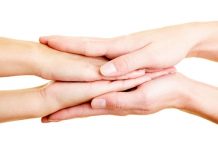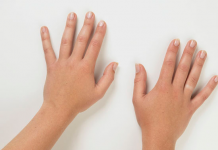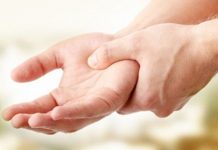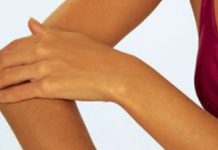GENERAL INFORMATION
Fascia is a kind of thin ligament tissue which is almost on all of the muscles of our body and which covers them as a nylon pacakge (figure1).
[auto_thumb width=”270″ height=”150″ link=”https://www.hakangundes.com.tr/wp-content/uploads/1i1.jpg” lightbox=”true” align=”center” title=”” alt=”” iframe=”false” frame=”true” crop=”true”]https://www.hakangundes.com.tr/wp-content/uploads/1i1.jpg[/auto_thumb]
In some parts of the body which do not have muscles, there is a fascia tissue just under the skin. Some of these parts are palm and sole.
Dupuytren disease is the abnormal thickhening of the tissue called fascia on the palm just under the skin (figure 2).
[auto_thumb width=”270″ height=”150″ link=”https://www.hakangundes.com.tr/wp-content/uploads/2i1.jpg” lightbox=”true” align=”center” title=”” alt=”” iframe=”false” frame=”true” crop=”true”]https://www.hakangundes.com.tr/wp-content/uploads/2i1.jpg[/auto_thumb]
WHY IT OCCURS?
The reason is not known. According to th statistics, it more commonly occurs on the men. Besides, it is found out that the lighter the skin color is, the more commonly it is seen. It is not proved that the hand injuries or any kind of jobs increase the rate of Dupuyytren disease.
In the studies made on biochemical (molecular) base, a cell type called “myofibroblast” is detected in the sick fascia of the palm. This is an immature cell type, meaning that it might change or develop as muscle or fibrosis in accordance with the conditions. It is suspected that a protein type called “α smoothmuscleactin” synthesised by this cell causes the abnormal behaviour of the cell or thickening and shortening of the palm fascia.
CLINICAL PICTURE
Thickened fascia is detected as palpable hardness like small nodules at the early stages. These are called palmarnodules (nodules) (figure 3). These nodules are so close to the skin to form a whole. In some cases, they can be considered as a skin disease by the patients. As the sick tissue holds the subcutaneous part, there becomes some small collapses. These are called pits (figure 4). Even though the disease effects the skin (i.e. tendons), it does not spread to the deep tissues. As the disease advances through the fascia in the palm, the thickened tissue starts to strain and shorten as a spring. This long, rope-like tissue is called cord (figure 5). After the formation of this tissue, the fingers curve and bend into the palm (figure 6). The bended fingers cannot open (get straight) by force. In most of the patients, both hands are effected bu in different levels.
The disease is generally not painfull. In other words, the most irritating part for the patients is not the pain. One of the significant findings in the next step after the formation of the nodule is that the palm cannot touch to a flat surface due to the bending on the fingers (figure 7). The hand functions are interrupted as the fingers are gradually bending. In the next steps, the patient cannot put his hend into his pocket or shake hands (figure 8). IT IS DIFFICULT TO ESTIMATE HOW FAST THE DISEASE WILL PROGRESS OR WHETHER IT WILL PROGRESS OR NOT. Some patients can be followed-up with one or two small nodules for years. General information is that the earlier age the disease occurs, the more probable it will progress.
In some people, the fascia tissue thickenes not only on the hand but also on the sole. This is called “MorbusLedderhose”.
TREATMENT
1-Nodule detection in the palm is not an indication that the disease will progress or require surgery.
2-The patients having only nodules should be observed and followed-up at regular intervals.
3-In the cases of cords causing no bending/curving on the fingers should be followed-up at more regular intervals.
4- Performing surgery when the fingers start to bend (at early stage) will result in better healing. This is the case especially for the PIP joints (figure 9).
[auto_thumb width=”270″ height=”150″ link=”https://www.hakangundes.com.tr/wp-content/uploads/9i1.jpg” lightbox=”true” align=”center” title=”” alt=”” iframe=”false” frame=”true” crop=”true”]https://www.hakangundes.com.tr/wp-content/uploads/9i1.jpg[/auto_thumb]
5-The appearance or shape may not fully heal. Similarly, for the patients applying at the highly advanced levels, trying to get full recovery might be risky for the fingers.
6-The aim in the surgical treatment is TO RECOVER THE HAND FUNCTIONS AS MUCH AS POSSIBLE. COSMETIC ISSUES SHOULD STAY IN THE BACKGROUND.
7-You should be realistic while making the treatment plan. The progress of the disease may not be stopped despite the surgical treatment. Besides, in some rare cases, it may cause faster progress.
8-Surgical treatment is not the only option. The sgtrained structures called cord can onyl be cut, the fascia havign pathology can be fully taken out (parcial fasciectomy ) (figure 10) or whole fascia can be taken out regardless of it is sick or not (sub total fasciectomy) (figure 12). Your surgeon will explain you the reasons of the surgical treatment he will perform.
9-In the last 1-2 years; there issued many USA based publications regarding the usage of an enzyme suppressing and removing the protein called collagenase or collagen with injection (needle) method. Even promising, I am in the opinion that we should wait for the long term follow-up results.
10-In some cases, skin should be taken from another part of the body and patched to the palm. This is generally required for advanced and spread diseases.
11-REGULAR REHABILITATION SHOULD BE PERFORMED AFTER THE SURGERY. THE AIM HERE IS TO MINIMISE THE LOSS TO BE OBSERVED IN THE ACQUIRED MOVEMENT LIMIT. BESIDES, THE STATE CALLED RSD AND PROGRESSES TOGETHER WITH CHRONIC PAIN AND LOSS OF MOVEMENT IS MOST COMMONLY SEEN AFTER DUPUYTREN SURGERY. Rehabilitation is also performed to prevent this condition (figure 13).
[auto_thumb width=”270″ height=”150″ link=”https://www.hakangundes.com.tr/wp-content/uploads/13i1.jpg” lightbox=”true” align=”center” title=”” alt=”” iframe=”false” frame=”true” crop=”true”]https://www.hakangundes.com.tr/wp-content/uploads/13i1.jpg[/auto_thumb]
WHAT IS THE PROGRESS OF SURGICAL TREATMENT, WHAT IS AHEAD OF US?
The Orthopedician or Hand Surgeon will ask for x-ray graphies after the consultation. What is aimed in here is the detection of whether there is arthritis-corrosion or not. MR, bone scintigraphy or CT (computurized tomografy) is generally not required. The stage of the disease is the main determinant for the selection of the surgical treatment to be performed. Your conditions are also effective in this decision. The effect on the right or left hand, your job and your expectations will be taken into consideration. In most of the surgical treatments, daycase or one night of hospitalization shall be required. It is very importat for you to mention about your special conditions (chronic diseases, reqularly taken medications, etc.) during your consultation with the anesthiologist. Most of the dupuytren surgeries are performed under local anesthesia. Cold application and keeping the hand above the heart level in the postop early stage (3 to 5 days) will relieve the pain and throbbing. In the postop period, a plaster or splint covering the wrist joint is applied. The application term of the plaster or the splint may vary between 3 weeks to 3 months in accordance with the performed surgical treatment. During this period, PHYSICAL THERAPY AND REHABILITAION STEP IS STARTED. THE AIM IS TI RECOVER THE HAND, WRIST AND ARM STRENGHT AND MINIMIZE THE LOSS TO BE OBSERVED ON THE ACQUIRED MOVEMENT LIMIT. Anyhow, the period will change in accordance with the applied surgical treatment and the condition of your hand.
PROBABLE COMPLICATIONS
1-General: Hematoma on the surgical wound area, infection, pressure feeling due to the splint, limitation of the finger movements due to the tissue adhesion are the most probable complications.
2-Unique to dupuytren: The most important complication is the recurrence or fastening of the disease. This probability increases in the hands inclined to sweating or callus.
3-Unique to dupuytren: The state called RSD and progresses together wıth chronıc paın and loss of movement ıs most commonly seen after dupuytren surgery.
4-Unique to dupuytren: another significant complication is the injury of the fine nerves on the surgical area. It is very important the operation should be performed with special glasses. In case of nevre injury, a long and troubled period starts (figure 12).
[auto_thumb width=”270″ height=”150″ link=”https://www.hakangundes.com.tr/wp-content/uploads/14i1.jpg” lightbox=”true” align=”center” title=”” alt=”” iframe=”false” frame=”true” crop=”true”]https://www.hakangundes.com.tr/wp-content/uploads/14i1.jpg[/auto_thumb]
5-another probable complication is to have late or not to have the expected results.
6-It should be taken into consideration that the dupuytren treatment is hard and long period. Sometimes, in case the progress of the disease does not get slower, another surgical intervention is required.












